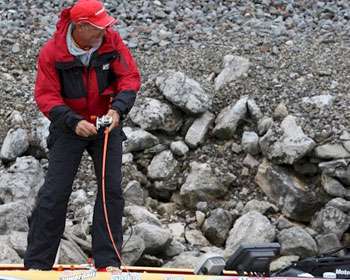
Cast, crank, repeat. Compared to the Rat-L-Trap, few lures on the market produce more consistently with as little effort or expertise. During the fall, these vibrating offerings become a deadly option for roaming bass. As 2007 Bassmaster Classic champion Boyd Duckett explains, taking advantage of this bite comes down to one thing: location.
"The Rat-L Trap is definitely one of my go-to baits in the fall and one of the most productive baits that you can throw in the fall," claimed the Alabama pro. "More than at any other time of the year, all the bass are doing in the fall is eating."
In early fall, when cold fronts drop the water temperature into the mid to high 70s, finding concentrations of quality bass can become a challenge.
"They leave the bottom contours, the brushpiles and the stumprows and start chasing bait," explained Duckett.
With a 'Trap, Duckett is able to closely mimic baitfish and cover "tons of water" while keeping his bait in the primary strike zone.
When beginning his search for fall bass on a reservoir, Duckett starts by keying on main-lake points. He slowly works his way back to secondary points and creeks in main-lake pockets. It all comes down to covering water. A half-dozen casts is all it takes for Duckett to determine whether there are bass in the area.
"I'll quickly fish the secondary points and start moving my way back into the creeks," he explained. "I'm trying to locate the baitfish. If I can find the bait, I can find the bass. The Rat-L-Trap is my search bait."
Early in the fall when the water is still warm, Duckett pays close attention to his electronics, looking for balls of bait in the 7- to 8-foot depth range.
"Early on, I like to move my bait fairly fast, but when I see balls of bait on my depthfinder, I'll use a yo-yo retrieve in order to run the Trap through the schools of bait."
Later in the fall, Duckett concentrates his efforts on the backs of pockets and creeks where schools of shad will gather and feed on phytoplankton blooms that are typically heaviest in these areas.
"The perfect pocket is one that has a big, shallow flat in 2 to 4 feet of water," he said. "In these instances, the 'Trap is an awfully good bait because you can wind it across the bottom and generate a really erratic action. You can catch every one of the bass in the back of a creek on a Rat-L-Trap."
When fishing these large flats, he is usually casting to open water void of any visible structure or cover. During the fall, the presence of baitfish trumps cover.
After he has located a school of feeding bass, Duckett usually stays with the lipless crankbait as his primary offering rather than switching to a different bait.
"Once I find the bass, I'll keep throwing my 'Trap because there are very few baits that the bass will bite better," he explained. That being said, Duckett will still follow up with a soft jerkbait or small topwater to pick up a few extra bites after the Rat-L-Trap bite has subsided.
Duckett's primary weapon is a 1/2-ounce crankbait in either a chrome/black or chrome/blue finish. During fall, he typically sticks to baitfish patterns and says that a painted shad pattern often outproduces its chrome counterpart in cloudy or low-light conditions.
By tying on a Rat-L-Trap in the fall, you can search, locate, catch and capitalize on aggressive bass that are feeding up for the winter.




